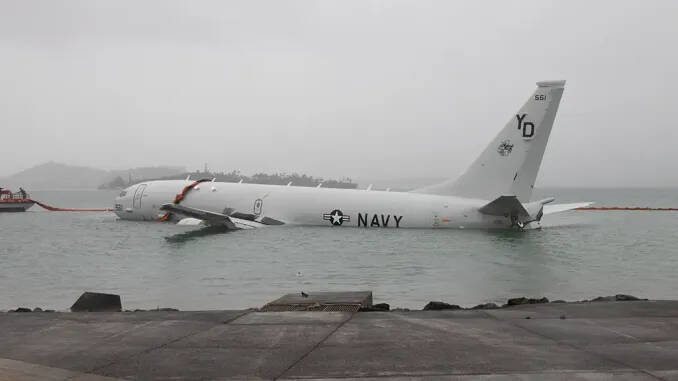There was no fuel released from the P-8A aircraft assigned to Whidbey Island that, on Nov. 20, overshot the runway while attempting to land on Marine Corps Air Station Kaneohe Bay in Hawaii, according to officials who spoke at a press conference held Monday at the Hawaiian base.
The cause of the accident is still unknown, but the Navy recovered a data recorder from the airplane.
Just minutes after the accident, a Navy Waterfront Operations team arrived on the scene to limit any environmental damage. In 30 minutes, the aircraft was surrounded by containment booms — used to capture any hazardous contaminants released in the water — which were on a boat already located in the bay. Later, the Navy was joined by teams from state agencies, according to Col. Jeremy Beaven, commanding officer of Marine Corps Base Hawaii.
Representatives of the salvage efforts who spoke during the conference estimated that the aircraft had just over 2,000 gallons of fuel on board.
On Sunday, a Navy team defueled the plane, something that had never been done to a P-8A underwater. The fuel appeared to be in perfect condition as a result of tests conducted early Monday. Rear Adm. Kevin P. Lenox, who is also the on-scene commander and commander of Carrier Strike Group 3, said they could “put that in another plane and it would be good to go.”
The officials said the aircraft is in remarkably good condition and its fuel system is intact. This means the plane can likely be put back into use after being removed from the water and being repaired. Removal might involve the use of a float and a crane, or giant rolls.
The plane is mostly sitting on its landing gear, with one of the engines resting on a coral reef. Once the airplane is removed from the site, environmental damage will be further assessed, but for now it seems that there have been no major impacts to the coral, as reported by Navy divers who conducted a hydrogeographic survey on the area surrounding the aircraft.
Lenox said that an administrative investigation is being conducted by a senior naval officer in the Maritime Patrol and Reconnaissance Force from outside the chain of command of the aircraft crew involved in the accident, along with an Aviation Mishap Board.
“The Navy is committed to learning from this investigation, regardless of the cause,” said Lenox. “These lessons be valuable in preventing such incidents going forward and making us better.”
The nine passengers involved in the accident — three pilots, two officers and four enlisted crew members — managed to evacuate on their own and reported no injuries. They are part of the Patrol Squadron 4 “Skinny Dragons,”, which is stationed on Whidbey Island and was on a detachment in support of maritime homeland defense. Patrol squadrons are no longer stationed at Kaneohe Bay, so they deploy to Hawaii from other bases in patrol missions.
Currently, the aircraft and crew are being replaced by a P-8A and crew assigned to VP-40 “Fighting Marlins” that arrived in Hawaii on Nov. 22.



